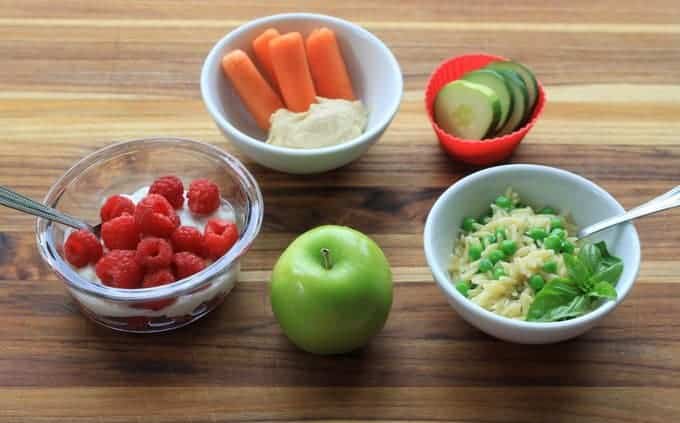We have all heard that the diet has to contain a large number of fruits and vegetables. But what does that mean? The experts are clear. A balanced diet, and better if it is based on the Mediterranean diet pattern, should contain at least five servings of fruit , vegetables a day, the general recommendation being three servings of fruit and two vegetables.
But in that at least lies the crux of the matter, that is the minimum and never the maximum.
What are the benefits of fruits and vegetables?
We already know that fruits have benefits, but why? This is because this food group provides a large number of vitamins and minerals, as well as being an excellent source of fiber and water and containing few calories and high satiating power.
In addition, a “sufficient daily consumption of both could contribute to the prevention of certain diseases, such as cardiovascular diseases, obesity, certain types of cancer …”, explains Cristina Porca Fernández to CuídatePlus. Ph.D. in Nutrition and member of the Spanish Society for the Study of Obesity (Seedo).
What is Serving?
Consuming five servings of fruits , vegetables per day is an excellent method to have a healthy diet. Yet, what exactly is one serving?
Serving sizes are defined as:
One cup of fruits or vegetables is one serving, according to the United States Department of Agriculture (USDA). Smaller fruits and vegetables, such as berries or miniature carrots, are considered half-cup portions. It’s crucial to note that not all fruits and vegetables have the same nutritional content, therefore eating a range of colors and varieties is encouraged.
Examples of What Makes Up One Serving
Fruits:
1 medium apple, banana, or orange
1 cup fresh berries, grapes, or melon
1⁄2 a cup of dried fruit
1 cup 100% fruit juice
Vegetables:
1 cup leafy greens like spinach or kale
12 cups cooked or raw veggies, such as carrots or broccoli
1 medium potato (or sweet potato)
1 cup vegetable juice
How to Measure Portion Sizes:
Measuring portions is a simple and effective approach to ensure that you’re getting the recommended quantity of fruits and veggies. These are some guidelines for measuring servings:
Use measuring cups: Measuring cups are an excellent way to correctly measure out one cup of fruits or vegetables.
Visualize: If you don’t have measuring cups on hand, consider the size of a tennis ball or a closed fist to imagine one serving.
Examine the label: Serving sizes are given on the nutrition label of several pre-packaged fruits and vegetables.
How to comply with the Five-day Recommendations?
It is true that sometimes it seems difficult to include those five pieces, at least, a day. Sometimes peeling the fruit is lazy. And other times you have to face myths that say that fruit should not be taken after eating or that you have to eat it afterward… So to make it easier and for this to have a positive impact on our health, it is convenient to make some changes in feeding. Katherine García Malpartida, a specialist in Endocrinology and Nutrition from the Nutrition Area of the Spanish Society of Endocrinology and Nutrition (SEEN), recommends:
Introduce a piece of fruit at breakfast.
At mid-morning take a piece of fruit or raw vegetables such as carrots, celery, tomatoes, etc.
Have a piece of fruit for dessert at lunch and dinner .
Consume a serving of vegetables (raw or cooked) at each main meal.
Accompany protein dishes (meat, fish, eggs) with half a serving of vegetables, in addition to the recommended serving of vegetables at each main meal.
Prepare cereal or rice dishes with vegetables .
It can also be useful, according to Diego Bellido Guerrero. specialist in Endocrinology and Nutrition and representative of Seedo, organize the weekly menu. “In this way we can see in advance if the objectives are met and it will help us when making the purchase. It is also convenient to prevent pre- cooked meals or unhealthy foods from entering our shopping basket that tend to displace the consumption of these fruits and vegetables”.
Examples of menus with fruits and vegetables
Once we have the theory we have to put it into practice. Here are two menus, drawn up by experts from Seedo and SEEN, that can help you include the right number of pieces of fruit and vegetables in your daily life:
Example of a daily menu containing six items:
Breakfast : natural yogurt with a piece of apple chopped into the yogurt and whole wheat toast with extra virgin olive oil.
Mid-morning: coffee with milk and a piece of peach.
Lunch: white bean salad with assorted vegetables (tomato, three-color peppers, onion, and broccoli) and a serving of cherries for dessert.
Snack: carrot sticks with chickpea hummus.
Dinner: cream of vegetables (potato, carrot, chard, tomato, zucchini, leek), baked sea bass and a pear.
Example of a daily menu containing five items:
Breakfast: Coffee with milk with whole wheat toast with virgin olive oil and tomato, orange.
Mid-morning: Apple.
Food: Mixed vegetable salad with chickpeas and cheese tacos.
Snack: Yogurt bowl with 3 nuts, strawberries and cinnamon.
Dinner: Gazpacho or stir-fried vegetables with grilled fish fillet.
If mid-morning or snack is not done, to reach the recommendations you should always have a piece of fruit for dessert.
Whole fruits or juice?
Although in summer you may want to drink a cold and refreshing juice, the truth is that from the point of view of health eating the whole fruit is much more convenient because all the nutrients, vitamins and fiber of the piece are ingested , in addition to be more satiating The ideal, in addition, is to eat it with skin .
Is it the same to eat a cooked vegetable than in gazpacho or cream?
A serving of vegetables is equivalent to about 150 grams of raw, peeled (if necessary) and clean vegetables. The World Health Organization recommends consuming more than 400 grams of fruits and vegetables a day to improve health and reduce the risk of developing non-communicable diseases. However, “most studies conclude that the benefits are achieved with a daily consumption of between 600-800 grams ,” says Bellido.
Healthy and balanced diets must contain variety in their foods and therefore it is necessary to consume both raw and cooked vegetables. That is why García advises integrating both types of preparation into the daily menu. “Raw vegetables offer all their nutrients intact, although they may be more difficult to digest. Cooking techniques that alter the properties of the vegetables as little as possible are recommended, such as steaming and pressure cooking.
Although the consumption of seasonal fruits and vegetables is recommended , buying frozen vegetables is another way to ensure daily consumption of the recommended servings by being able to store them in the freezer. Of course, although using frozen vegetables is a healthy option, you must make sure that they do not include preservatives or additives that could alter their composition.
What culinary techniques preserve the nutrients of vegetables?
Since vegetables lose part of their nutrients when cooked, it is advisable to include at least one daily serving of them raw . García points out that when steaming the vitamins and minerals remain in the food by preventing them from coming into contact with water, while cooking quickly with the pressure cooker achieves the same effect.
The following tips can be carried out:
Avoid exposing fruits to light.
Wash the whole vegetables and cut them afterwards.
Use the minimum amount of water to cook the vegetables, since part of the vitamins and minerals are released in the cooking broth.
Cook the vegetables in large pieces and with the covered container.
Do not exceed the optimum cooking point.
Consume the broth from cooking the vegetables. García recalls that you should not “consume the broth of vegetables rich in nitrates such as spinach, chard, beets, radishes, turnips, and fennel”
FAQS:
What are the healthiest fruits and vegetables to eat everyday?
Dark leafy greens like spinach and kale, berries rich in antioxidants, cruciferous veggies like broccoli, and citrus fruits loaded with vitamin C are among the healthiest choices for daily consumption.
What are the 10 best and healthiest vegetables to eat?
Spinach, kale, broccoli, Brussels sprouts, bell peppers, carrots, sweet potatoes, tomatoes, cucumbers, and cauliflower are among the top 10 healthiest vegetables, packed with vitamins, minerals, and antioxidants.
Which fruits and vegetables should be eaten regularly?
Berries, apples, bananas, oranges, spinach, kale, broccoli, carrots, bell peppers, and tomatoes should be eaten regularly for a diverse range of vitamins, minerals, and antioxidants essential for overall health.
Conclusion:
In conclusion , Incorporating at least five servings of fruits and vegetables daily, as suggested by experts, provides essential vitamins, minerals, fiber, and hydration, reducing the risk of diseases like cardiovascular issues and cancer.
Video Credits:
If you have any confusion or questions related to this topic do Let Us Know

Dr. Mark Jenkins, MD - General Physician (California, USA)
Dr. Mark Jenkins is a board-certified general physician based in the United States, specializing in preventive medicine, nutrition, and lifestyle health. With years of clinical experience in primary care, he is dedicated to helping patients and readers alike make informed, science-based decisions about their well-being.
As a trusted medical reviewer and contributor to Healthfness.com, Dr. Jenkins ensures that all health content meets the highest standards of accuracy, safety, and evidence-based medicine. His expertise bridges modern medical science with practical, everyday wellness strategies, making complex topics approachable for all audiences.
Outside the clinic, Dr. Jenkins is passionate about living the healthy lifestyle he teaches. He enjoys hiking with his dog, experimenting with vegetarian cooking, and exploring the latest health research. He believes that small, consistent lifestyle changes lead to lasting health improvements, and he aims to inspire readers to take proactive steps toward a healthier, happier life.
Explore more of Dr. Jenkins’ evidence-based insights at Healthfness.com




